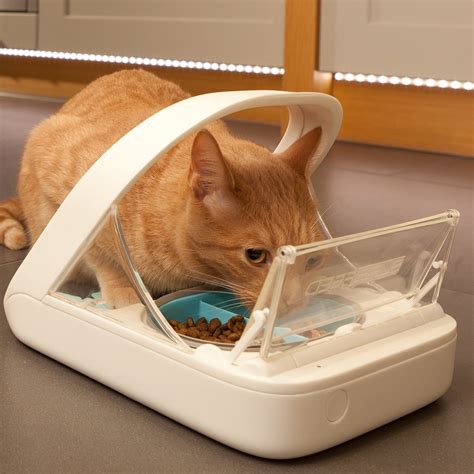Introduction
Cats are beloved companions, but their feeding habits can be unpredictable and stressful, particularly for busy or traveling pet owners. Fortunately, advances in pet care technology have introduced automatic cat feeders as a revolutionary solution to address this challenge. These devices provide precise and timely feeding, minimizing stress for both cats and their owners.

Benefits of Automatic Cat Feeders for Reduced Stress
1. Consistent Feeding Schedules
Automatic cat feeders allow owners to program mealtimes, ensuring that their feline friends receive food at regular intervals. This eliminates the stress associated with unpredictable feeding, which can lead to anxiety and digestive issues in cats. By providing a consistent routine, automatic feeders promote a sense of stability and predictability for both pets and their owners.
2. Stress-Free Absence
Busy schedules and occasional trips can be highly stressful for cats who rely on human attention for feeding. Automatic feeders bridge this gap by enabling owners to provide food remotely, even when away from home. This reduces the anxiety and stress that cats may experience when diting alone for extended periods.
3. Portion Control for Optimal Health
Overfeeding is a common problem among cats, contributing to weight gain and other health issues. Automatic feeders offer precise portion control, ensuring that cats receive the appropriate amount of food for their size and activity level. By regulating caloric intake, automatic feeders promote optimal health and well-being for cats.
How Automatic Cat Feeders Work
1. Programming
Automatic cat feeders are typically programmed using a control panel or a mobile app. Owners can set specific feeding times, portion sizes, and meal frequencies, allowing for customized feeding schedules tailored to each cat’s needs.
2. Food Storage
The feeders have built-in food dispensers that can hold dry food for multiple days. Some advanced models even allow for the storage of wet food or treats.
3. Timed Release
At the programmed time, the feeder automatically releases the desired portion of food into a bowl or tray, providing timely and consistent nourishment for the cat.
Types of Automatic Cat Feeders
Automatic cat feeders come in various types to suit different needs and preferences:
| Type | Features | Benefits |
|---|---|---|
| Gravity | Food is stored in a hopper and released by gravity | Simple and cost-efficient |
| Timer | Food is released at predetermined times | Consistent feeding schedule |
| Portion Control | Food is dispensed in precise amounts | Promotes weight management |
| Smart | Connects to Wi-Fi or Bluetooth, allowing remote monitoring and control | Advanced features for convenience and customization |
Choosing an Automatic Cat Feeder
When selecting an automatic cat feeder, consider the following factors:
- Cat’s needs: Age, size, activity level, and any dietary restrictions.
- Features: Timer, portion control, food storage capacity, and remote connectivity.
- Capacity: Food storage capacity to accommodate multiple days of feeding.
- Power source: Battery or electrical power source to ensure consistent operation.
- Ease of use: Simplicity of programming and maintenance.
Transitioning Your Cat to an Automatic Feeder
To mitigate stress during the transition, follow these steps:
- Introduce Gradually: Place the feeder near your cat’s regular feeding spot and leave it unplugged.
- Start with Small Portions: Fill the feeder with a small amount of food and program it for a single meal.
- Encourage Interaction: Place your cat’s favorite treats in the feeder to encourage exploration.
- Monitor Progress: Observe your cat’s behavior around the feeder and adjust as needed.
- Be Patient: Allow your cat time to adjust to the new routine.
Advancements in technology are continuously enhancing the capabilities of automatic cat feeders:
- Biometric Identification: Feeders that identify individual cats using microchips or facial recognition to provide personalized feeding.
- Remote Monitoring: Advanced feeders equipped with cameras and sensors to allow real-time monitoring of feeding habits and cat behavior.
- Automated Food Replenishment: Feeders integrated with delivery systems that automatically reorder food when supplies run low.
- Health Monitoring: Feeders that monitor food consumption and provide insights into cat health, facilitating early detection of potential issues.
Conclusion
Automatic cat feeders are an innovative solution to the stress associated with unpredictable feeding schedules, travel, and overfeeding. By providing consistent nourishment, portion control, and remote accessibility, these devices enhance the well-being of cats and reduce the anxiety of their owners. As technology continues to advance, automatic cat feeders will become even more sophisticated, offering additional convenience, customization, and peace of mind for pet owners and their feline companions.





















